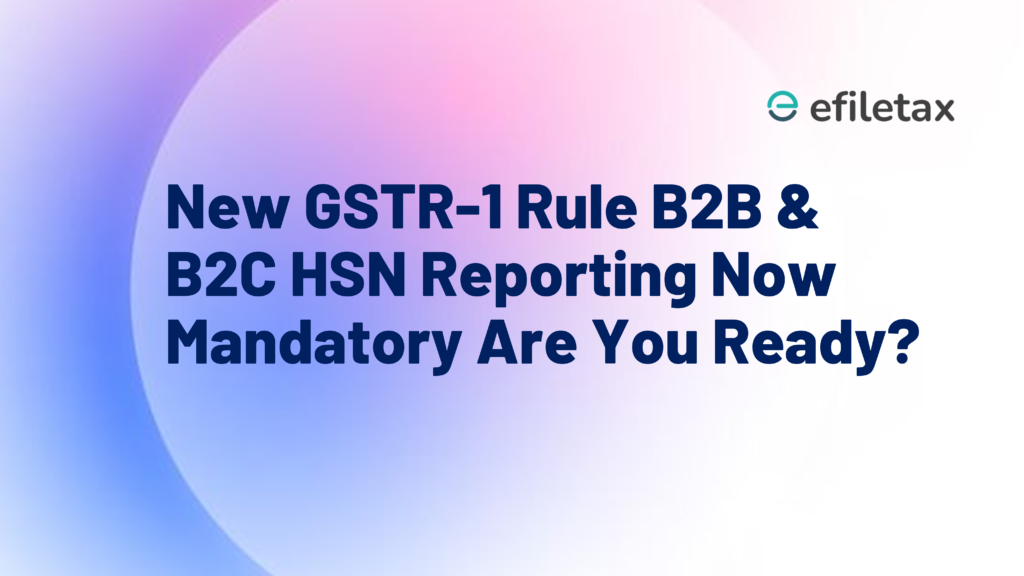
HSN Reporting in GSTR-1 What’s Changed?
Starting April 1, 2025, the Goods and Services Tax Network (GSTN) has enforced mandatory separate HSN-wise reporting for B2B and B2C supplies in GSTR-1. This move is aimed at improving data accuracy and easing tax administration, but it also brings new compliance responsibilities for taxpayers.
Let’s simplify what this update means for you.
Why Is Separate HSN Reporting in GSTR-1 Mandatory Now?
As per the GSTN Advisory dated 20th May 2025, the portal now requires businesses to report HSN summary separately for B2B and B2C outward supplies in Table 12 of GSTR-1.
Earlier, taxpayers could combine HSN details for all outward supplies. But from April 2025 onwards:
- Separate rows must be entered for B2B and B2C invoices.
- System will not allow saving or filing unless segregation is done.
This change ensures:
- Better data analytics for GST officers
- More transparency across invoices
- Reduced mismatches in GSTR-2B reconciliation
Who Needs to Follow the New HSN Reporting Rule?
All regular taxpayers filing monthly or quarterly GSTR-1 returns, including:
- Private Limited Companies
- LLPs and Partnership Firms
- Proprietors with GST registration
- Ecommerce sellers
- Service providers above threshold
Exemptions:
Composition taxpayers filing CMP-08 are not affected.
How to File HSN Summary Separately in GSTR-1?
Here’s a quick step-by-step guide:
| Step | Action to Take |
|---|---|
| 1. | Login to GST portal and go to GSTR-1 return dashboard |
| 2. | Navigate to Table 12 (HSN-wise summary) |
| 3. | Add HSN details for B2B invoices in one row |
| 4. | Add separate HSN details for B2C invoices in another row |
| 5. | Ensure quantity, taxable value, and tax amounts match outward supply tables |
| 6. | Save, validate, and file GSTR-1 as usual |
👉 System won’t accept if both B2B and B2C values are clubbed together in a single row.
Expert Tip: Avoid Rejection Errors
“Prepare HSN data offline using Excel template provided by GSTN. Upload it after verifying B2B/B2C segregation.”
– CA Priya Mahadevan, GST Consultant
Legal Reference
This update flows from the CBIC mandate under Rule 59 of the CGST Rules, 2017, read with the GST Council’s focus on high-value supply tracking. It aligns with GST Council recommendations for real-time invoice-level compliance.
Why It Matters: Key Impacts
✅ Accurate input tax credit flow
✅ Better GST audit readiness
✅ Prevents demand notices due to data mismatch
✅ Easier e-invoice vs GSTR-1 reconciliation
Common Mistakes to Avoid
- ❌ Mixing B2B and B2C values under one HSN code
- ❌ Ignoring nil-rated and exempted supplies under HSN
- ❌ Filing GSTR-1 without validating Table 12 summary
Summary
GSTN now mandates separate HSN reporting in GSTR-1 for B2B and B2C supplies from April 2025. Non-compliance may lead to return filing errors. Learn the updated filing process and compliance checklist on Efiletax.
FAQ Section
Q1. Is this update applicable to quarterly filers under QRMP scheme?
Yes. Even quarterly filers must report HSN details separately for B2B and B2C when filing GSTR-1.
Q2. Can I leave Table 12 blank if I’ve no HSN?
No. HSN summary is mandatory for all taxable supplies as per turnover-based rules.
Q3. What happens if I don’t segregate B2B and B2C HSN data?
The portal will reject your GSTR-1 submission and prompt for corrections.
Final Words
Separate HSN reporting in GSTR-1 is no longer optional. It’s time to get your invoices and ERP systems ready. At Efiletax, our experts help businesses stay compliant and error-free.